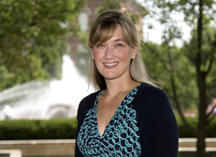Prof: Nation's first military park celebrates battle's 150th anniversary
September 16, 2013
 |
|
Caroline E. Janney |
WEST LAFAYETTE, Ind. — There are dozens of Civil War battle anniversaries being recognized during the war's 150th anniversary, but one that stands out is Chickamauga because it's the nation's first military park, says a Purdue University historian.
"Prior to the creation of the military park at Chickamauga, private groups, corporations and donors were the force behind memorials and monuments," says Caroline E. Janney, an associate professor of history. Her research focuses on memory and the Civil War. "These private interests, especially in the Civil War's aftermath, were not always moving the nation forward with reunion and reconciliation."
For example, Gettysburg National Military Park, which is the most popular Civil War battlefield, was created first and foremost as a union memorial field, Janney says. Plans for other national government military parks, including Antietam, Shiloh and Gettysburg, followed the Chickamauga & Chattanooga National Military Park announcement.
Plans to establish a national park at Chickamauga began in 1897 during the silver anniversary. By adding the nearby battle of Chattanooga to the legislation, promoters believed it would help the nation heal. It would honor both a Union and Confederate victory.
The plan for the park was approved in 1890, and the federal government dedicated it in 1895, 32 years after the Sept. 19,1863 battle. The Chickamauga battle marked the union's most significant loss and one of the bloodiest of the war. It was second only to Gettysburg in casualties.
"The common saying is the winner writes history, and the private interest groups and individual states were telling the story they wanted to tell through these memorials," Janney says.
"With national government oversight, the memorial planners could promote reconciliation by ensuring that both sides were equally represented in the processions and dedication services, and ultimately the memorial.
"But moving forward in harmony also meant ignoring the causes and consequences of the war. Newspaper reports from the 1895 dedication heralded cordial veterans on both sides, but sectionalism was alive and well."
Janney's research on Chickamauga and the differences between reunion and reconciliation is the focus of her recent book, "Remembering the Civil War: Reunion and the Limits of Reconciliation." Janney also is the president-elect for the Society of Civil War Historians and author of "Burying the Dead but Not the Past: Ladies' Memorial Associations and the Lost Cause."
Writer: Amy Patterson Neubert, 765-494-9723, apatterson@purdue.edu
Source: Caroline E. Janney, cjanney@purdue.edu
Related websites:
College of Liberal Arts
